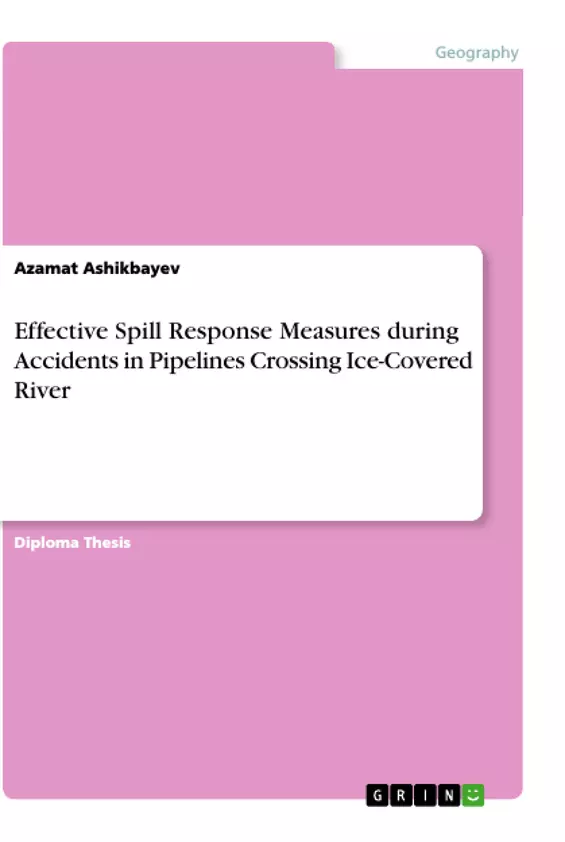The aim of the present study is to develop and determine effective spill localization methods for ice-covered rivers. Oil spills from pipelines crossing ice-covered river can have a harmful effect on the river and its inhabitants. Existing spill response techniques might be effective during the warm season of a year; however, during winter oil recovery is complicated by the presence of ice cover. The pipeline networks are rapidly increasing around the world for the last 10-20 years due to increased demand for energy. Pipelines are more reliable and safer mode of transportation in comparison to railway or oil tankers. However, each year there are hundreds of pipeline failures, sometimes resulting in significant environmental pollution, loss of transportation capacity and restoration expenses.
When a spill is restrained below a solid ice, the infected area cannot be directly identified. Therefore, a pipeline rupture incident under ice-covered river should be considered as one of the worst-case scenarios in pipeline crossing design and spill response planning. Responding to a spill in the ice environment presents many challenges that are not met during the warmer months of the year. Government-sponsored organizations as well as oil companies are undertaking numerous Research and Development activities to improve spill response capabilities in challenging environments. Many of the tools and spill response techniques need to be verified for river conditions.
Implementing successful spill response measures is a challenge for every party involved in response operations. Good understanding of oil behaviour in ice-covered waters can improve response preparedness during winter and facilitate response during actual spills. Spill response techniques in ice-covered rivers are similar and rely on downstream movement of oil under ice. Generally, it is assumed that oil beneath ice will move with the current. However, the force of flow is different in various rivers and cannot be uniform even along the same river. This means that ignoring current velocity and using one method in all types of rivers can lead to ineffective and messy response actions. Concerning this, research into spill response methods for ice-covered rivers is important in order to improve industry preparedness for the challenges of cold-weather response.
Inhaltsverzeichnis (Table of Contents)
- Abstract
- Dedication
- Acknowledgements
- Chapter 1: Introduction
- 1.1 Background
- 1.2 Problem Statement
- 1.3 Objectives
- 1.4 Scope of Study
- 1.5 Significance of Study
- Chapter 2: Literature Review
- 2.1 Oil Spill Response Techniques
- 2.2 Ice Cover and Oil Spill
- 2.3 Hydrodynamics of Ice-Covered River
- Chapter 3: Methodology
- 3.1 Laboratory Experiments
- 3.2 Field Observations
- Chapter 4: Results and Discussion
- 4.1 Oil Spill Localization
- 4.2 Oil Movement Beneath Ice
- 4.3 Limitations of Existing Techniques
- 4.4 Concept Device for Oil Localization
- Chapter 5: Conclusions and Recommendations
Zielsetzung und Themenschwerpunkte (Objectives and Key Themes)
This study aims to investigate and determine effective spill localization methods for ice-covered rivers, focusing on the challenges of oil spill response in such environments.
- Analysis of existing spill response techniques in relation to ice-covered rivers.
- Investigation of oil movement under ice cover and its dependence on river hydrodynamics.
- Evaluation of the effectiveness of conventional methods based on downstream slick movement.
- Development of a conceptual device for oil localization in ice-covered rivers.
- Contribution to the advancement of spill response strategies in challenging environments.
Zusammenfassung der Kapitel (Chapter Summaries)
- Chapter 1: Introduction: This chapter sets the context of the study by introducing the problem of oil spills from pipelines crossing ice-covered rivers, highlighting the potential environmental harm and the need for effective response measures.
- Chapter 2: Literature Review: This chapter presents a comprehensive overview of existing literature related to oil spill response techniques, the impact of ice cover on spills, and the hydrodynamics of ice-covered rivers.
- Chapter 3: Methodology: This chapter outlines the research methods employed in the study, including laboratory experiments and field observations.
- Chapter 4: Results and Discussion: This chapter presents the findings of the study, analyzing oil spill localization methods, the behavior of oil slicks beneath ice, the limitations of existing techniques, and a proposed concept device for oil localization in ice-covered rivers.
Schlüsselwörter (Keywords)
Oil spills, pipelines, ice-covered rivers, spill response, localization, hydrodynamics, oil movement, concept device, environmental impact, research findings.
- Arbeit zitieren
- Azamat Ashikbayev (Autor:in), 2013, Effective Spill Response Measures during Accidents in Pipelines Crossing Ice-Covered River, München, GRIN Verlag, https://www.grin.com/document/1161455



